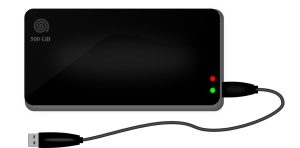13.5 Organization and Storage
Students need to keep their work organized. Once you start working on multiple assignments, you want to be able to find and access your work easily. If you aren’t used to keeping your files organized, then this section will be very important for you. There are two parts to keeping your work organized: saving and backing up.
Saving
Some people save everything on their desktop or in their documents file. They just hit save and let it save to the default destination. This results in a huge collection of documents in one place. This can make it hard to see what documents you have, and to find them when you are looking for them. It’s the equivalent of having a huge pile of papers sitting on your desk, and you can’t find anything. This is true for all documents, whether it is for work, volunteer organizations, random household documents, or vacation planning. As a student, it often makes sense to create file folders for each course you are taking. File folders are just like what you would expect in a regular filing cabinet. A filing cabinet contains file folders usually organized in alphabetical order, or possibly by theme. Inside the file folders are all the documents pertaining to that topic. Students should make a file for each course. Then it’s important to name the documents carefully so that they are easy to identify. That way you can pull a document out of a file at any time. Once you have saved a document into a file folder (using the “Save As” function) then it will automatically save it in the same place every time you hit “Save”. You should hit save often to make sure you don’t lose your work if a sudden power outage occurs or your computer fails or shuts down suddenly.
You can have file folders within file folders. For example, you may have a file folder named College Courses. When you open that folder, you could have sub-folders named for each of your courses. Within each folder you can have all the documents which are related to that course – your assignments, labs, saved reference material, etc. Then it’s easy to locate your documents. The more courses you take, the more you will appreciate having your documents saved in an orderly manner.
Whenever you are working on an assignment or research paper, make sure to save regularly. Saving regularly is critical. There is nothing more frustrating than putting your heart and soul into an assignment, only to lose it. It usually happens to every student once, because it is a hard lesson to learn. Once they have suffered the loss of a lot of hard work put into an assignment, students rarely allow that to happen to themselves again. Students need to save their material regularly.
Researchers Perspective
I usually hit the save button about every paragraph. Sometimes I hit it more often if I have struggled to word a sentence just right; I’ll hit save immediately as soon as I’m happy with it. Anytime I’ve fiddled with sizing a picture or wrapped text around a picture and fussed with it until I’m happy with the layout, I hit save. Anytime I’ve created a link or formatted all the headings, I hit save. Whenever I’ve cut and pasted information, or moved chunks around on the page, I hit save. If I’m going to hop up from the computer to make a cup of tea, I hit save. That way if I get distracted and come back later, I know the file has been saved. My motto is to save often enough that you wouldn’t be frustrated if you lost the unsaved data and had to recreate it. For me that’s virtually every 5-10 sentences or every paragraph. If you can’t remember the last time you hit save, then hit save!
Mary Shier, College of the Rockie
Backing Up
Backing up your documents is critical. Just as losing unsaved material is frustrating, so is losing entire documents that have been saved. Back-ups provide extra copies of your important documents (which includes your course assignments) in a separate location, just in case. Some insist you should have two back-ups for all your important documents. You can lose your data for various reasons: your computer dies suddenly and you can’t recover any of the documents; your computer gets a virus and the documents are destroyed; your computer has hot coffee accidentally spilled on it, or is thrown in a mud puddle by your helpful toddler; the power goes out after several hours of typing, but you realize you didn’t save the document because you were so focused; the document mysteriously disappears off your computer; maybe someone unknowingly hit “Delete,” or it got saved off into cyberspace somewhere. Sometimes there are no explanations as to why a very important homework assignment goes completely missing days before it is due.
The answer is to back up your material regularly. There are several options to do this.

Memory stick: Use a memory stick to have your assignments saved on an external storage device. At the end of every work session, store your work on your computer (where you should have been hitting saveall along) and on a separate memory device. The advantage is you can carry your stick with you wherever you go and work on it on other computers if needed. If choosing this as an extra back-up, remember – it isn’t useful if it’s still attached to your laptop when you drop the laptop in the lake. Then both the lap top and the memory stick are hooped. A back-up is only a back-up if it is in a separate place than the original copy. If the computer and memory stick are both in your computer bag, and the computer bag goes missing, you’ve lost your back-up too.
Student drives: Educational institutions are often on a network drive. Students then receive their own personal drive which can be accessed with their student number and password. This ensures that students using college computers can save their work on their personal drive. No-one else can access, revise, or delete their work because it’s stored under their own personal drive. The other advantage is that the student drive can be accessed from any computer in the building. Students don’t have to wait for a specific computer to access their documents.

External hard drive: Many people back up their files on an external hard drive. This provides a second copy of their files which is stored in the home or office. The advantage of this method is that all files are stored and backed up in the same place. In the case of an emergency such as a fire, the external hard drive can be grabbed and will have all important files and pictures on it.
The Cloud: Cloud storage is convenient and can be accessed from anywhere there is access to the internet. Cloud storage such as Google Docs, Xdrive, MediaMax, DropBox, OneDrive, and Strongspace are especially handy, because even if your home explodes and takes your electronics and storage devices with it, your documents are still safe.
Email: This is one of the easiest ways to back up your work while you are still working on it. If every now and then (say after you have done a significant enough amount of work that you’d be upset if you lost it) email the document to yourself. You can name it Draft 1, Draft 2, Draft 3 and so on. That way it’s available from anywhere that has connectivity and you have the most recent back-ups of your work.
Regardless of which tool you use, make sure to save and back up your school work! Save every few minutes and back up every work session. You will be glad you did!
“8.4 Organization and Storage” from Student Success by Mary Shier is licensed under a Creative Commons Attribution 4.0 International License, except where otherwise noted.

